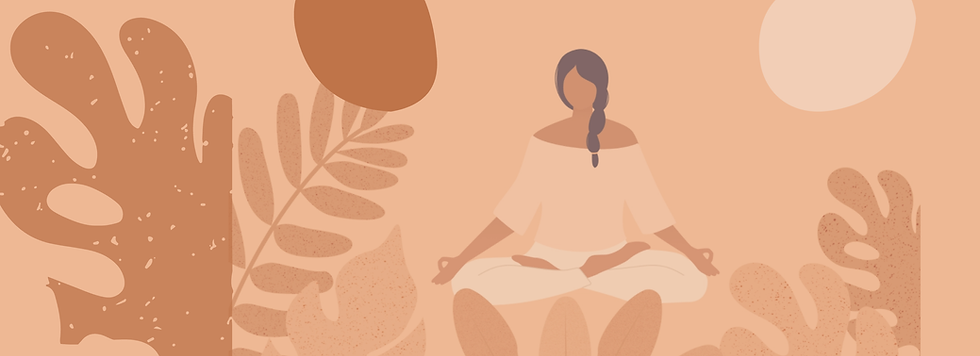Breathe Easy
- Apr 26, 2022
- 5 min read
Discover the stress-relieving power of your breath and how you can utilize it anytime, anywhere.
Written by Samra Karamustafic

When it comes to stress relief, your breath is regularly touted as an incredibly powerful, no-fail remedy to a raised heart rate, sweaty palms and overall tension.
Think about it: breathing is at the core of nearly all mindfulness practices, from yoga to meditation. In fact, it’s safe to say that if you were to go on Pinterest right now and search up “mindfulness quotes,” there would be at least one or two quotes that have to do with the power of your breath.
So is it overhyped, or is breathing just that effective? By the title of this article, you probably already know the answer to this question (yes, it is!), but there are a few reasons why.
Let’s first begin with what happens in our brains when we experience anxiety.
In her book “Own It: Make Your Anxiety Work For You,” author Caroline Foran does a fantastic job of explaining what happens in our brains when we feel stressed or anxious. She notes that there are four key players when it comes to this process: the amygdala, the hippocampus, stress hormones and the sympathetic nervous system.
The amygdala, a walnut-shaped structure located behind both of our ears, handles our emotions and is responsible for triggering any signals of fear in the brain. The amygdala interacts with the hippocampus (a structure that plays a major role in memory and learning) and together they connect an emotion to an event, which then leads to the release of stress hormones. As the brain pumps out these stress hormones, your sympathetic nervous system then triggers the fight-or-flight response.
This response isn’t a bad thing — in fact, it’s played a primary role in keeping our ancestors alive whenever they stumbled across an apex predator while on their morning walk. The issue is that, as Foran specifies, sometimes our amygdala can become a bit overactive and think that you’re in danger when you’re actually not. Additionally, the amygdala can also trigger the release of stress hormones long after a stressful event occurred.
And because the amygdala is one of many memory systems in the brain, it can sometimes even trigger negative feelings and memories when you encounter something in the present day that is in any way similar to a traumatic or stressful event from your past.
This is where our breath comes in to help us alleviate these stress reactions.
Breathing has a much more significant effect on our body’s stress response than you may think. In fact, according to UW Medicine, you can induce a state of panic by taking in short and shallow breaths from your chest (however, please don’t try that!).
Alternatively, breathing can calm you down if you’re feeling tense, stressed or anxious. This is because breathing — primarily deep breathing — can “help quiet your sympathetic nervous system,” as UW Medicine states. By quieting your sympathetic nervous system, you’re therefore reducing those feelings of stress and anxiety from the fight-or-flight response.
Using your breath as relief is not only free, but you can do it anywhere — whether that’s in your car, during a yoga class or at the supermarket. If you ever find yourself going through a stressful situation, or you feel as though you simply need to take a (literal) breather, check out these effective breathing techniques that you can try anywhere, anytime!
Disclaimer: The content in this article is not intended to be a substitute for professional advice, diagnosis or treatment. Always seek the advice of your doctor or another health provider with any questions you may have regarding mental health.
1. Nadi Shodhana Pranayama
Nadi Shodhana Pranayama, commonly known as “alternate nostril breathing,” is a simple yet effective breathing technique that, according to the Chopra Center, can “restore balance and ease in the mind and body.” A breathing technique commonly used to control rhythm in yogic practices, alternate nostril breathing can also quiet the mind, alleviate your body’s stress response and regulate the nervous system.
HOW-TO:
Sit in a comfortable seat, making sure that you’re sitting up tall and not slouching
Taking your right hand, place the pointer and middle fingers between your eyebrows. Keep in mind that the ring finger and thumb will be used throughout this exercise.
Take a deep breath in and out through your nose
Close your right nostril with your right thumb and inhale through the left nostril for three seconds.
Don’t exhale just yet; take your thumb off your right nostril then close the left nostril with your right ring finger
Slowly exhale through the right nostril, pausing briefly at the end of the exhalation.
Keeping your left nostril closed, inhale through the right nostril for three seconds.
Repeat this cycle 5-10 times, or as much as needed, with your eyes closed.
2. 4-7-8 Breathing
Another highly touted breathing technique is “4-7-8 Breathing,” developed by Dr. Andrew Weil. Besides reducing stress and anxiety, Medical News Today notes that the 4-7-8 Breathing technique can also help you fall asleep, manage cravings, and even help control or reduce anger.
HOW-TO:
As the name suggests, this technique consists of breathwork falling alongside a count of four, seven, and eight.
First, relax in a comfortable position (either seated or laying down).
Inhale through your nose for a count of four.
Hold your breath for a count of seven.
Exhale through your mouth (making a “whooshing” sound) for a count of eight.
Both Healthline and WebMD suggest practicing this technique for a total of four cycles when starting out, while gradually working your way up to eight cycles.
3. Belly Breathing
The third breathing technique is belly breathing, more formally known as diaphragmatic breathing. This breathing technique is especially useful in alleviating stress and anxiety due to, as PBS notes, its ability to reduce our heart rate and trigger a relaxation response. When breathing normally, only your chest cavity expands. The breath gets even shallower if your body enters fight-or-flight mode due to a stressor. However, as Medical Today points out, belly breathing not only engages both the chest cavity and diaphragm (the large muscle in our abdomen), but it increases our lungs’ efficacy. The best part? Belly breathing and the fight-or-flight response cannot coexist, which is what makes it such a useful tool to quickly alleviate any tension or anxiety.
HOW-TO:
Sit or lie down in a comfortable position
Place one of your hands on your stomach (below your ribs) and the other hand on your chest
Take a deep breath in through your nose, allowing your stomach to fill up with air. It should feel as though your belly is expanding and pushing your hand up.
Purse your lips (as if you’re about to whistle or sip through a straw) and breathe out slowly, feeling your stomach gently contract and your hand going back down.
Repeat this technique as needed.






